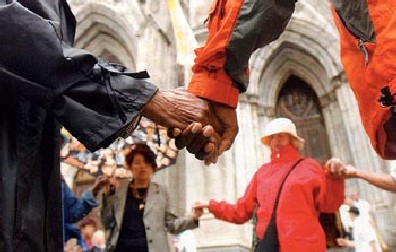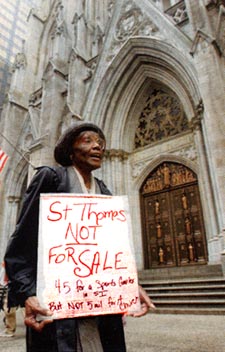 |
NEWS: January 22, 2004
Bird’s Eye View of the News
Atila Sinke Guimarães
CLOSING CHURCHES – Last summer the Archdiocese of New York closed the parishes of St. Thomas the Apostle (Harlem) and Our Lady of Guadalupe (Manhattan, 14th Street). The number of closings could grow to as many as 25 of Manhattan’s 104 historic Catholic churches, say some sources close to the Archdiocese.

A demonstration in front of St. Patrick's Cathedral to protest the closing of Harlem's St. Thomas the Apostle Church
Preservation magazine, January - February 2004
|
These closings are included in a general plan to reorganize New York’s 413 parishes. As reason for the closings, Cardinal Edward Egan, Archbishop of New York, blames shortages of priests and high maintenance costs in old urban parishes (Preservation magazine, January - February 2004, pp. 9-11).
The sincerity of this excuse seems open to discussion, as the following episode reveals. After countless difficulties, the parishioners of St. Thomas met with Bishop Timothy McDonnell, who told them the Archdiocese had closed the church because a restoration would cost $5 million, which was prohibitively expensive. The parishioners, however, asked a parallel estimate for the same work, and the costs were revealed to be about $2 million – $3 million less than what the Bishop told them. They offered to raise this amount among themselves. Church leaders thanked the faithful for their initiative, but no thanks, the church would remain closed. It is interesting to note that these parishioners, mostly African Americans, are on the whole poor (ibid.).
Since the Archdiocese padlocked St. Thomas and Our Lady of Guadalupe with less than a week of notice to their congregations, a climate of quiet panic has seized New York’s Catholics. “We never knew for sure what was happening until we showed up for church one Sunday and found the doors locked,” says Jocelyn Williams, a member of St. Thomas. “Everyone is wondering: ‘Will my church be the next?’” says Jeffrey Smith, a parishioner of St. Ann’s, a neo-Gothic church built in 1852 on East 110th Street.
The African American parishioners of St. Thomas couldn’t get an explanation for its closure from the Archdiocese until the city’s politicians intervened. Marching, shouting slogans, carrying placards, and praying in front of St. Patrick Cathedral, they protested the closing of their parishes.

The Diocese has not ruled out the possibility of selling the buildings
Preservation magazine, January - February 2004
|
The Archdiocese did not exclude the possibility of selling the buildings: “Selling church property to private developers is not a priority, but is a possibility,” says Joseph Zwilling, spokesman for the Archdiocese.
Downsizing seems likely to be repeated in other cities of the country. A decade ago, mass closings swept through Chicago (32 parishes, 20 schools), Detroit (31 parishes), and Pittsburgh (38 parishes) (ibid). The curious thing is that Los Angeles and Milwaukee are included in Dioceses that most probably will soon start to sell churches as well. The reason offered is the same as in New York – the expense of maintenance. These two Dioceses, however, recently took on huge expenses with two monumental works – the extravagant reform of Milwaukee Cathedral by former Archbishop Rembert Weakland, and the building of the monstrous Cathedral of Los Angelesby Cardinal Roger Mahony. How to explain, then, that there was plenty of money to build those artistic nightmares and now money is lacking even to maintain the existent churches?
The closing of churches is not only an American phenomenon. Good sources in Germany said the Archdiocese of Berlin plans to close its only seminary and 101 of its 207 parishes in 2004 (America, December 8, 2004).
To close beautiful majestic churches is an old progressivist longing that wants to finish with the sacral characteristic of the Catholic Church. Instead, they would establish a poor and even miserable Church. This was the ultimate aim of John XXIII when he preached that the Catholic Church should be transformed into a Poor Church, as well as of Paul VI, who had the plan to sell St. Peter’s Basilica. (1)
1. Please check my book Animus Delendi I (Los Angeles: TIA, 2000), pp. 397-399.
SELLING DIOCESAN PALACES – Archbishop Sean O’Malley of Boston has put up the Archdiocesan Palace and 28 surrounding acres for sale to help pay for clerical abuse suits. Cardinal William O’Connell, who is buried on the grounds, built the palazzo in Italian Renaissance style. In the 1920s, it was seen as a symbol of the new-found religious importance of Massachusetts Catholics, many of whom had arrived in the New World in the mid-1800s as impoverished Irish peasants. O’Connell successors have all resided there until now.

The Boston Archdiocesan grounds includes the Bishop's residence, center foreground. St. John's Seminary is at the upper right
|
A leading Catholic layman of Boston, Raymond Flynn, former mayor and US ambassador to the Holy See, professed “deeply mixed emotions” about the sale. His parents were poor Irish immigrants who had contributed to the construction of the residence, and he regretted the blow to the prestige of Boston Catholicism. “A certain dignity has to be associated with the Church. I don’t want us to be somewhere that we are tucked away,” he said, “I want people to look up to us” (The Tablet, London, December 13, 2003, p. 31).
I strongly agree with Mr. Flynn, and support his point. The palace should not be sold. I really don’t understand why wealthy Catholics, like those in Los Angeles who pledged several hundred million dollars to build its monstrous Cathedral, could not be appealed to. It doesn’t seem likely that they would let this symbol of Catholic grandeur and prestige be lost for good.
Incidentally, Archbishop O’Malley is not offering only the Archdiocesan Palace for sale. He has already mortgaged the Cathedral of Boston and St. John’s Seminary (Le Monde des Religions, Paris, January-February 2004, p. 7).
At any rate, like the cost of Church maintenance in New York, the pedophile scandal in the clergy of Boston is offering another good pretext to give away the symbols of grandeur of the Catholic Church in this country, and Archbishop O’Malley is carrying out this important step of the progressivist agenda.
CLAMOR FOR A NEW COUNCIL – On the topic of the progressivist agenda, the call made last December by Cardinal Stephen Hamao, the Japanese Cardinal who heads the Vatican office for migrants, is remarkable. In an interview to the Italian magazine Famiglia Cristiana, Humeo called for a Third Ecumenical Vatican Council to speed up decentralizing the Church. According to the Prelate, the present day Synods are not sufficient since they are too formal and supposedly controlled by the Roman Curia.
In his plan for decentralization, he calls for allowing regional churches to decide for themselves what to do regarding the needs of Catholic evangelization. He gives the example of Asia, where he says the “proclamation of the Gospel has to be gradual.” He noted “If I proclaim that Jesus Christ is the only savior of humanity, I risk preaching to deaf ears” (The Leavenworth Times, December 26, 2003).
That is, he is not content with the present day ecumenism, which already hides a great deal of the Catholic Faith in order not to upset the followers of false creeds. He pretends that the local churches in Asia need to veil Our Lord even more in order to attract pagans. Humeo was made Cardinal by John Paul II last October.
CHANGING THE PAPACY – Another point of the progressivist agenda that continues to be pushed is the change in the Papacy to please the Protestants and Schismatics. In an interview with 30 Giorni in Rome, Cardinal Godfried Danneels, Archbishop of Brussels, suggested the power of the Papacy be reduced and that there be less focus on the person of the Pope. Danneels criticized the Vatican’s “centralized control” of recent centuries. He is widely seen as the rising star of the progressivist current (The Tablet, January 3, 2004, p. 24).

|
News | Home | Books | CDs | Search | Contact Us | Donate

©2002- Tradition in Action, Inc. All Rights Reserved
|
 |
|